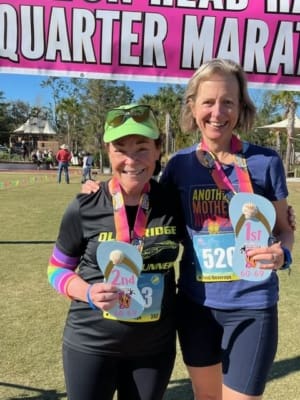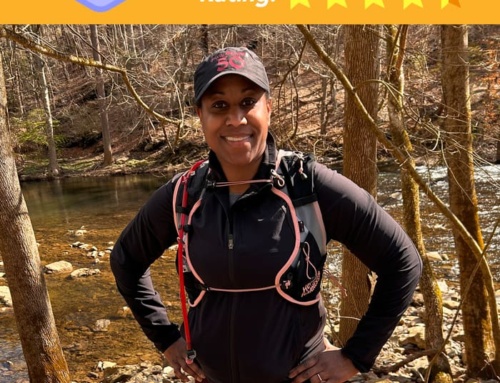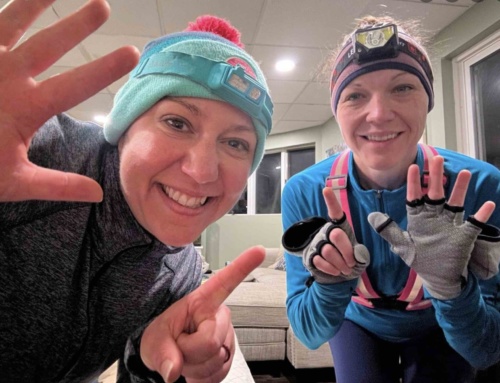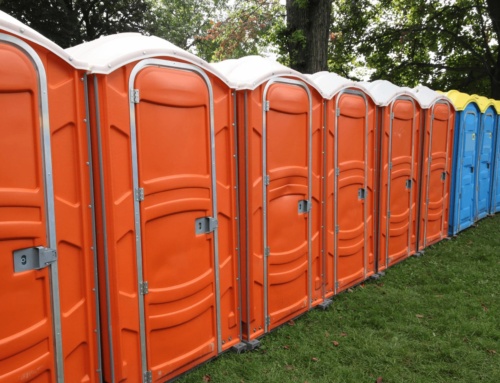This two-part mini-series is adapted from a session podcast co-host and veteran runner Tish Hamilton led at our Hilton Head Island Retreat last month.

Hilton Head quarter marathon: Kathleen Blinn, Matawan, NJ (69) and I (61) took first and second in the 60-69 age group. While I technically beat her by about a minute, my “age-graded” time is 46:49, while hers is 42:33. Woot!
Who wants to run forever? You! I’ve run 58 marathons over 35 years, and I worked for nearly 14 years as Executive Editor at Runner’s World magazine. Longevity is my superpower.
Yes, at age 61, I’m tired. Yes, I’m slowing. And, yes, I recognize the privilege of being able to run six miles most mornings. In the words of wise writer Margeret Renkl, “Sorrow in the face of aging would be a poor response to such good fortune.”
And, anyway, my 95-year-old mother, who walks a mile every day, reports that the real slowdown doesn’t happen until after age 75. Whew.
Here are some truths and tips I’ve learned along the way.
Truth: You change
You know it’s coming, but it sneaks up on you, gradually and then suddenly, wrote Ernest Hemingway. Starting in our 30s, women lose up to 8% of muscle mass per decade, according to research from the University of Southern California, and more after age 60.
Tip: Strength-training 3x per week is the obvious answer, with particular attention to clamshells (to protect stabilizing hips) and calf raises (to improve balance and forward momentum).
Truth: Your feet hurt
Even if you weren’t a runner, by the time you reach your 50th birthday, your feet have covered more than 50,000 miles. No wonder they hurt! What’s more, by age 40, women start losing fat—nature’s cushioning—in our heels. You may need more cushioning now. You may even need to wear a bigger size shoe.
Tip: Alternate running shoes—different brands, different models. One study showed runners who alternated shoes had 39% lower risk of injury. Why? Different shoes change up how your foot lands and works, which lessens the chance of overuse.
Truth: You get wobbly
Running is actually a single-leg activity as we move from one foot to the other. We rely on single-leg strength to keep us steady and to catch us if we start to fall. Balance and the ability to sense the position of our body in space (proprioception) decline as we age, putting us at risk for trips, falls, and injuries.
Tip: Stand on one leg! Kudos if you’re able to put on socks and shoes while standing on one leg. If that’s too hard (as it is for me), simply stand on one leg for 30 seconds while you’re waiting for the toast to pop up or brushing your teeth.
Truth: You get creaky
Your legs, knees, back, hips, and ankles may complain more often and more loudly with each passing year, especially when first thing in the morning or when you get up from a chair. Warming up for a run and getting to that point where the run feels comfortable will take longer.
Tip: Dynamic stretches, such as gently swinging your leg back and forth or side to side, move you through a range of motion without strain and wake up your muscles before you run. (Here’s a video of Dimity demo’ing a dynamic warmup series.) You may start every run with a walk—and that’s okay!
Tish shares more truths + tips in a Friday blog post.






Thank you! Very informative!
[…] two-part mini-series, which kicked off here on Tuesday, is adapted from a session podcast co-host and veteran runner Tish Hamilton led at our Hilton Head […]
[…] we got bonus insight into one team member, podcast co-host and website columnist Tish Hamilton, who asserted, “I’m going to vote for taking the word ‘guilty’ out of […]